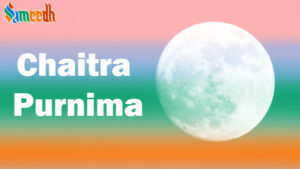Chaitra Purnima is the full moon day that falls in the Hindu lunar month of Chaitra, typically occurring in March or April in the Gregorian calendar. It holds significance in Hinduism, particularly in relation to various festivals and rituals celebrated during this time.

“Purnima” (Puranmashi) is a Sanskrit term meaning “fullmoon.” In Hinduism and several other Indian religions and cultures, Purnima holds significant spiritual and religious significance. It occurs on the fifteenth day (Purnima Tithi) of the lunar month in the Hindu calendar, typically every month. Chaitra Purnima is one of the twelve Purnima or Pooranmashi occurring in a year.
Chaitra Purnima marks the culmination of Chaitra Navratri, a nine-day festival dedicated to the worship of Goddess Durga. Devotees observe fasts, perform rituals, and offer prayers to seek the blessings of the Goddess for prosperity, protection, and spiritual fulfillment.
In some regions, Chaitra Purnima is celebrated as Hanuman Jayanti, the birthday of Lord Hanuman, the devoted disciple of Lord Ram. Devotees worship Lord Hanuman and recite his prayers and hymns to seek his blessings for strength, courage, and protection from evil forces.
In North India, there is a connection between Ganga Dussehra and Chaitra Purnima in the sense that both are associated with the reverence and worship of the sacred river Ganges (Ganga). While Chaitra Purnima is not specifically designated as Ganga Dussehra, it is considered auspicious for bathing in the Ganges and performing rituals dedicated to the river goddess. Devotees often take holy dips in the Ganges on Chaitra Purnima as well, seeking purification and blessings from the divine river.
Rituals and Celebrations:
This auspicious day begins with a very important ritual of waking up early and take a holy bath in a nearby river before sunrise. Then, after observing the holy dip and offering Jal to the morning sun, devotees are supposed to worship Lord Vishnu and Lord Hanuman by visiting their temples.
Devotees faithfully worship Lord Vishnu by keeping a spiritual Satyanarayan Katha and fast. In addition, they are required to perform Vedic rituals and make sacred food that is offered to the idol and guests. Moreover, to extend the spiritual practices, devotees attend various reading sessions for Bhagwad Gita and Ramayan as well to worship deities and pray for prosperity and happiness.
One more significant part of this day is charity work. People wholeheartedly donate clothes, food, money, and many other items to attain peace and offer gratitude and devotion to God.
As per Hindu scriptures, every Purnima holds unique significance related to different Gods. But because Chaitra Purnima is the first full moon day of the Hindu calendar, it has received an immensely profound meaning in the Hindu culture.
Apart from these main festivals, Chaitra Purnima is considered auspicious for general worship, fasting, charity, and spiritual practices. It is believed that observing virtuous deeds on this day brings merit and spiritual progress.
Chaitra Purnima marks the beginning of the Hindu New Year in some traditional Hindu calendars, such as the Vikram Samvat and the Bengali calendar. It signifies the onset of spring and new beginnings, making it a time for renewal, spiritual growth, and celebration in Hindu communities.
